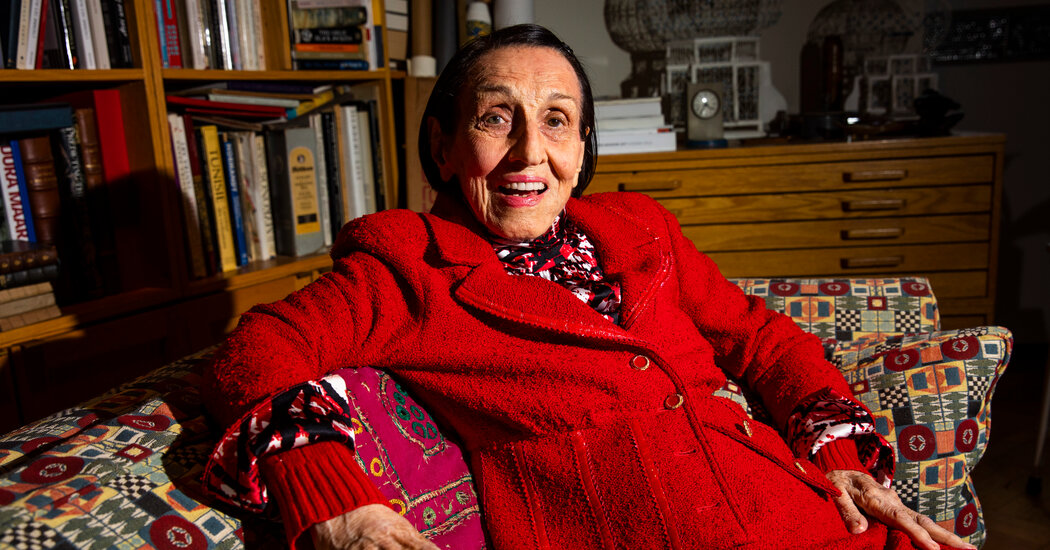The painter, writer and the only woman with the spunk and self-determination to leave Picasso has a few things to say about success, personal style and the nature of intimacy.
Seated bolt upright on a cream-colored sofa, Françoise Gilot was as grave as an oracle, an impression enhanced by her precision-tailored flame red suit.
“I wear red as a kind of protection, an affirmation of character,” she said. “It allows me to show myself the way I want to be seen.”
It was her expression — a blend of mischief, vulnerability and tentative warmth — that gave her away. “I am shy,” Ms. Gilot said more than once during a rare interview late last month on the Upper West Side of Manhattan, in the apartment that is also her studio.
Never mind the stir she created with the 1964 publication of “Life With Picasso,” a blisteringly candid account of her 10-year relationship with the artist. (She was the only woman to have walked out on him.) Or her stature as an artist: Her works are exhibited in more than a dozen museums, including the Metropolitan Museum of Art, the Museum of Modern Art and the Centre Pompidou in Paris, their prices on the rise.
Some now hang in her home, an airy refuge with barrel-vaulted ceilings, towering bookcases and an outsize window that bathes her canvases in a cool north light. There are works on every wall and stacked along the studio’s perimeter. Two abstract oils are propped like monuments on easels near the door.
But Ms. Gilot herself is no monument. “I am not going to make a big deal of being more than what I am,” she said. “Or less.”
Yes, it has been unsettling, if not entirely unwelcome, to find herself courted in recent months by art world pundits and the oddly assorted curiosity seekers who approach her with the kind of reverence one might reserve for a living repository of mid-20th-century culture — an idol and “it girl” at the unlikely age of 100.
“The idea!,” she said, smiling, perhaps a bit coyly. “For me painting is a silent art.” And an artist’s work ought to speak for itself, even if, as she added with a self-deprecating chuckle, “We are not always sure what we communicate.”
She is happy to have visitors sketch in the details. “You show them whatever they like to imagine about you,” she said. “But I am not the way they think I am.”
Then, with a conspiratorial nod toward Aurelia Engel, her youngest daughter and her archivist, who sat nearby, she signaled that it may be time to drop her guard. Just don’t ask her to repeat herself.
She has said much of what she has to say in “Life With Picasso,” written with Carlton Lake, an American journalist. Her father, an agronomist, made clear to his daughter from an early age that he would have preferred a boy. When she showed a fear of blood and heights, he responded by making her climb tall rocks and jump.
“My only possible reaction was anger,” she writes. “But since I could not show my anger, I began to nourish an inner resentment.”
By the time she was 8, she had toughened. “I sought out difficulty and danger. I had become another person. I felt the need of going too far simply to prove to myself that I was capable of it.”
She strayed far from her haute bourgeois upbringing, turning her back on the father who had insisted that she study law, for the bohemian life. As detailed in the memoir, Picasso, 61, and a towering figure when they met, smooth-talked Ms. Gilot, who was 21, into sharing his home on the Rue Saint-Augustin in Paris. He provided her with her own studio and encouraged her to paint. In turn, she doted on him, becoming his bookkeeper, intellectual interpreter and the mother of their children, Claude and Paloma. The relationship flourished — for a time.
But family life was not the walk on the beach portrayed in the famous Robert Capa photograph of Ms. Gilot traipsing on the sand at Golfe-Juan in the South of France, Picasso screening her with a colossal parasol. In darker moments, he was given to parading in front of her a string of would-be rivals, most famously Dora Maar, the painter and photographer, and Olga Khokhlova, his first wife, a Russian dancer who trailed the couple wherever they chose to holiday.
Ms. Gilot writes that Picasso showed Gilot great tenderness, but also subjected her to fits of lacerating cruelty. “You were a Venus when I met you,” he tells her soon after the birth of Paloma. “Now you’re a Christ — and a Romanesque Christ at that, with all the ribs sticking out to be counted.” Once, at the height of an argument, he threatened to burn her. “He took the cigarette he was smoking and touched it to my right cheek and held it there,” she writes. “He must have expected me to pull away, but I was determined not to give him the satisfaction.”
So attentively did she document his methods and musings that she risked effacing her own personality. In the book she recounts Picasso’s friend André Gide once chiding him, “It’s easy to see there’s a dimension to her inner life which has escaped you.”
Ms. Gilot has since become more forthright. As she spoke, she leaned in to tell me, “We are approximately the same age, products of the same generation,” a remark that prompted Ms. Engel to gently interject, “Mother, you are 100.”
Ms. Gilot lifted her eyebrows and shrugged.
“As young women, we were taught to keep silent,” she went on. “We were taught early that taking second place is easier than first. You tell yourself that’s all right, but it’s not all right. It is important that we learn to express ourselves, to say what it is that we like, that we want.”
She has not always been above using her looks to further her aims. Soon after they met, she writes, she took up Picasso’s invitation to teach her engraving. “I arrived on time wearing a black velvet dress with a high white lace collar, my dark red hair done up in a coiffure I had taken from a painting of the Infanta by Velázquez.”
When he remarked that her turnout was ill-suited for engraving, she informed him that she knew he had no intention of teaching that day. “I was simply trying to look beautiful,” she told him.
“Maybe I rather like the way I look,” she said in her apartment. Dressed in a lively mélange of pink and gold stripes, royal blue or her signature red, she can turn heads. “A sense of style is important,” she said. “It’s like a pane of glass that makes you seem transparent but at the same time is a barrier.”
Barriers can be handy. “You should not make yourself known that much to other people and keep your most intimate thoughts to yourself,” she said. Even with a husband? “Especially with a husband,” she said, erupting into peals of laughter.
Leaving Picasso was an attenuated process, the relationship ending in 1953. Two years later, she married Ms. Engel’s father, the artist Luc Simon. They divorced in 1962, and in 1970 she wed Jonas Salk, the developer of the polio vaccine, the union lasting until Mr. Salk’s death in 1995.
“I think you had more power in your marriages to my father and to Jonas,” Ms. Engel said. “You were often very nurturing, helping them find themselves and express themselves.”
To which Ms. Gilot responded with mock chagrin: “Just listen to what comes out of the mouths of children.”
That wryness abounds in her memoir too. In the book she recalls a moment when Claude, a small boy, pleaded to be allowed into her studio. Loitering just outside her door, he wheedled, “I love you, Mama.” No luck. He liked her painting, he told her, adding after a time, “It’s better than Papa’s.” At that, she weakened and welcomed him inside.
Had she ever felt competitive with Picasso or his friends, a cohort that famously included Chagall, Braque, Matisse and Giacometti? “That never entered my mind,” she said. “I started painting, after all, at 3 years old. As a child, you aren’t thinking in terms of me, me, me. You are not capable of that.”
What is more, she said: “The people I was with were so evolved. I was full of admiration for them.”
“But they also helped me grow,” she added with some cheek. “I realized, if they are so great, then I am not so small.”
In the eyes of the art world, Ms. Gilot is substantial indeed. Last May, her painting “Paloma à la Guitare,” a 1965 portrait of her daughter, sold for $1.3 million at Sotheby’s in London, at seven times its high estimate.
Shows of her work opened late last year at the Estrine Museum in Saint-Rémy-de-Provence, France, at Varfok Gallery in Budapest and at Galerie Patrick and Jillian Mac Fine Art in New Orleans. At Christie’s in Hong Kong, “Living Forest,” an 1977 abstract canvas that was part of a major retrospective at the auction house in November, sold for $1.3 million.
She would have you believe that she takes it all in stride. “She is less concerned with her career,” Ms. Engel said, because, as her mother recently told her, “‘It is already done.’”
Ms. Gilot has for the moment laid her brushes aside. But she is still evolving. “It’s very difficult to become who you are,” she said. “People tell you to be natural. But what is natural, I would like to know?”
She resists what she calls “too much order,” too much striving for consistency. “It’s important to be a bit naïve, to be spontaneous,” she said. “Often the first thought that comes to mind is the right one.”
She underscored the point, referring to her paintings of the early 1960s, a series inspired by the myth of Theseus and Ariadne. “Maybe they are most representative of who I am now,” she said. “I see life as a labyrinth. You don’t fight it. You go where it takes you.
Or, as she added after a beat, “You go the other way.”



























